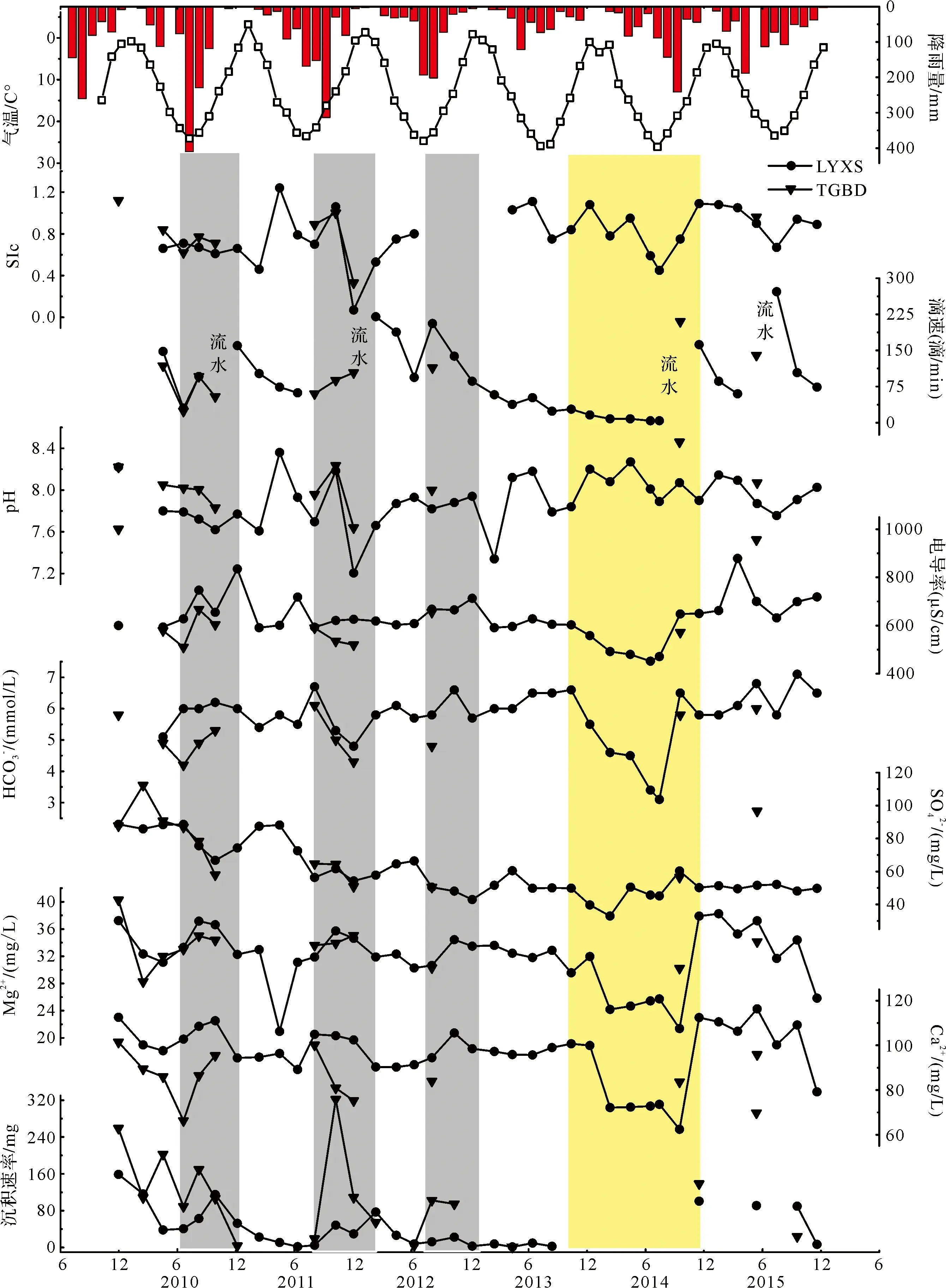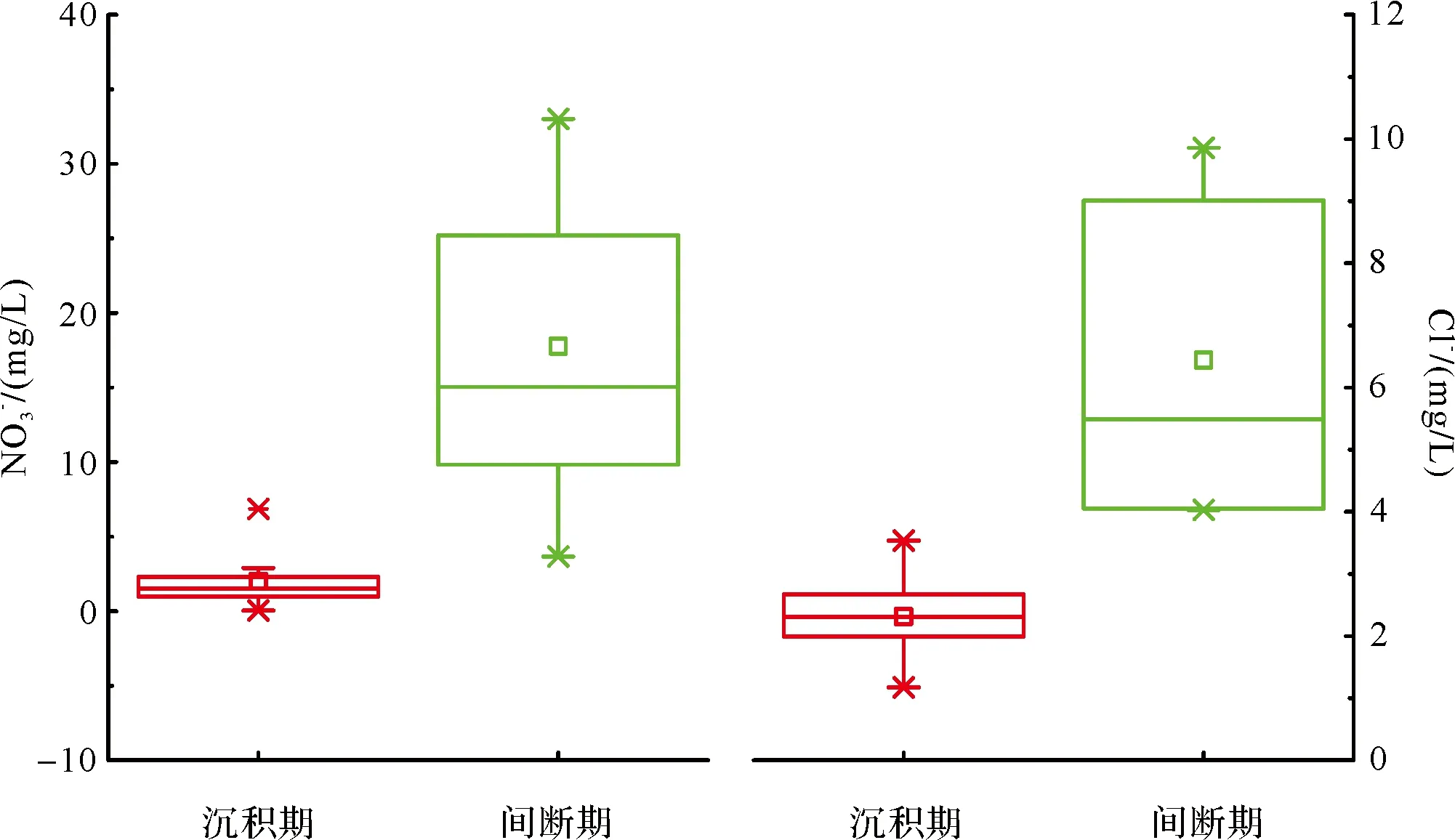岩溶洞穴现代沉积间断的影响因素研究
——以河南鸡冠洞为例
孙喆,杨琰,施强,张萍,梁沙,张娜,刘肖,聂旭东,彭涛,梁胜利,张志钦
1.西南大学地理科学学院/三峡库区生态环境教育部重点实验室,重庆 400715 2.国土资源部岩溶生态环境—重庆南川野外基地,重庆 408435 3.西南大学地球化学与同位素实验室,重庆 400715 4.河南省地质矿产勘查开发局第一地质矿产调查院,河南洛阳 471023 5.中国气象局武汉暴雨研究所/暴雨监测预警湖北省重点实验室,武汉 430074 6.河南省栾川县气象局,河南栾川 471500 7.鸡冠洞风景名胜区管理处,河南栾川 471500
岩溶洞穴现代沉积间断的影响因素研究
——以河南鸡冠洞为例
孙喆1,2,3,杨琰1,2,3,施强4,张萍1,2,3,梁沙1,2,3,张娜1,2,3,刘肖1,2,3,聂旭东1,2,3,彭涛5,梁胜利6,张志钦7
1.西南大学地理科学学院/三峡库区生态环境教育部重点实验室,重庆 400715 2.国土资源部岩溶生态环境—重庆南川野外基地,重庆 408435 3.西南大学地球化学与同位素实验室,重庆 400715 4.河南省地质矿产勘查开发局第一地质矿产调查院,河南洛阳 471023 5.中国气象局武汉暴雨研究所/暴雨监测预警湖北省重点实验室,武汉 430074 6.河南省栾川县气象局,河南栾川 471500 7.鸡冠洞风景名胜区管理处,河南栾川 471500


岩溶洞穴次生沉积物—石笋因其独有的高精度测年[1-2]、高分辨率记录[3]的优势和丰富的气候替代指标[4-8],在第四纪全球变化研究中的作用愈发重要。洞穴碳酸盐沉积机理研究作为理解石笋沉积速率,结晶形态和准确解译气候替代指标以及现代洞穴合理保护的理论基础,一直以来是岩溶洞穴研究的热点[9-15]。当前国内外研究成果主要来自于洞穴监测[10,13-14,16]和模拟计算[17-18],不过由于洞穴次生沉积受到不同区域气候条件的影响[12-13],碳酸盐沉积形成的时间及环境影响因素存在较大的差异,其记录的环境气候信息亦可能不同。例如,张美良[19]在广西盘龙洞的研究认为该洞对气候环境响应敏感,气温、降水和土壤CO2影响滴水饱和度,是导致沉积速率雨季大于旱季的原因。甘肃万象洞[20]的研究证明,滴水饱和度是沉积发生的必要前提,但沉积速率受洞穴CO2的制约,呈现旱季大于雨季。Casteel[21]在研究美国德州一处洞穴时发现,与同地区其他洞穴夏季受洞内CO2抑制相反,该洞由于通风条件好,洞内CO2浓度与外界接近,不存在对方解石沉积的抑制,其沉积速率与滴水微量元素受温度驱动,夏季沉积最快。即便在相似的气候背景下,南京葫芦洞却没有像安徽蓬莱仙洞一样表现出活跃的现代沉积特征[22]。沉积间断是石笋记录中经常遇到的现象,导致石笋间断的原因有很多[23],当前对沉积机理的研究多为讨论沉积的季节、年际特征的影响因素[10,19-20],对沉积间断原因的分析较少,选择一个出现沉积—间断—再次沉积的洞穴进行分析,对于深入理解岩溶洞穴沉积过程是大有裨益的。
鸡冠洞位于河南省洛阳市栾川县,处在我国南北交汇带季风敏感区,其特殊的地理位置暗示着对环境响应的敏感性,赵景耀[24]通过对洞内不同类型水的稳定氢氧同位素分析验证了“环流效应”[25-26],刘肖[27]对滴水、地下河和池水的水化学指标研究认为该洞对外界环境响应敏感,可以记录极端气候事件。笔者自2009年开始对其进行监测工作,发现在2013—2014年存在超过一年的沉积间断,并于2014年11月重新开始沉积,这为洞穴沉积机理研究提供了很好的素材,本文通过对鸡冠洞滴水和碳酸盐沉积物的观测与分析,探究影响洞穴沉积的因素,为石笋沉积间断的形成、石笋年层计数和环境信息解译提供理论依据,对现代洞穴保护具有现实意义。
1 研究区概况
鸡冠洞(33°46′N,111°34′E)位于黄土高原东南缘,河南省洛阳市栾川县城西4 km处的鸡冠山上(图1),洞口海拔约900 m,洞内长约5 600 m,分上下5层,落差约138 m。已开发洞长1 800 m,观赏面积达23 000 m2。洞内实测均温16.4℃。据栾川气象资料统计,鸡冠洞所在地区年均温约13.09℃,年降水量844.85 mm,7—9月为降水集中期,约占全年降水的52%。上覆基岩较薄,约30~40 m;土壤层为棕壤,厚度不大,10~30 cm左右[28];基岩裸露达10%~30%。植被主要是次生壳斗科、松柏科乔木和低矮灌木。区内地质条件较为复杂,碳酸盐岩岩溶作用强烈,研究区属华北及昆仑秦岭地层区,碳酸岩盐类主要出露蓟县系大理岩、青白系硅质白云石大理岩、震旦系大理岩(鸡冠洞岩性为震旦系绿泥大理岩)、二叠系变质大理岩。构造以三川—栾川复向斜为主体,次级褶皱发育,因构造应力比较集中,各种性质的裂隙以及低次级构造面发育,在次级褶皱构造的轴部,特别是垂直于轴部走向的张裂往往呈羽毛状排列[29]。鸡冠洞地处秦岭—淮河北侧,位于长江、黄河两大流域分水岭,又是中国地理南北湿润区与半干旱区过渡地带,特殊的地理位置决定了该区对亚洲夏季风变化响应的敏感性[30]。

图1 鸡冠洞地理位置Fig.1 Location of Jiguan Cave
2 材料与方法

式中,Kc为方解石溶解于水的平衡常数。
3 结果与讨论
3.1 滴水水文与水化学特征
洞内两处滴水类型不同,LYXS监测期间未曾断流,受强降水和持续降雨影响在2010年10月,2011年8—12月,2014年9月和2015年5月出现滴水变流水的情况;受栾川地区百年一遇大旱影响,2014年6月和7月滴速最小:4滴/min;正常降雨情况下LYXS滴水较稳定。TGBD雨季滴水稳定,滴速:24~118滴/min,对干旱事件响应敏感,易出现断流。区内2012—2013年降雨量显著下降,自2012年10月出现长达2年的干旱事件,滴水断流,两处滴水均很好地响应降雨量的变化。

图2 滴水物化指标和沉积速率变化注:流水代表滴速太快,已成线状,无法测滴速Fig.2 Variations of physicochemical indices and deposition rate at drip site
监测期间滴水pH波动较大:7.21~8.46,表现为在雨季出现低值,旱季升高,在2010年7月和2011年9月降水较同期显著偏多的月份(滴水变流水)之后并未表现出稀释作用[32-33],这与甘肃万象洞[20]及贵州石将军洞[34]的观测结果相同。受降雨量逐年减少的影响,pH值在2014年均值达到最大,指示滴水饱和度达到最低。


表1 池水、地下河旱、雨季水化学特征(修改自文献[27])
3.2 现代沉积速率

图3 鸡冠洞现代沉积物结晶晶体(修改自文献[35])a.LYXS现代沉积物晶体; b.TGBD现代沉积物晶体Fig.3 Crystal of modern speleothem in Jiguan Cave(modified from literature [35])

鸡冠洞的沉积特征与我国北方洞穴沉积过程主要发生在冬季不同,该洞受蒸发、空气交换有一定的影响,将强烈影响洞内二氧化碳分压(pCO2)的变化。岩溶洞穴沉积物主要源于滴水中CO2脱气作用使得水体过饱和析出碳酸钙(CaCO3),滴水与洞内pCO2差异推动该反应发生[10,36]。统计滴水处的洞内pCO2,雨季较旱季高14%,这是由于雨季植物呼吸作用和微生物活动加强,土壤CO2浓度升高,经岩溶管道和裂隙进入洞内的CO2增加,滴水脱气也会促进洞内CO2浓度的升高,但与封闭洞穴相比[11-12],鸡冠洞洞内雨旱两季pCO2差别不大,雨季洞穴CO2对沉积的抑制作用被滴水饱和度“掩盖”。




图4 沉积期与间断期滴水Cl-和对比Fig.4 Comparisons of Cl- and in drip water between sedimentary and hiatus period

综合上述分析可以发现鸡冠洞现代沉积对水热条件响应敏感,能够反映季节、年际间的大气降水量、滴水滴速、滴水饱和度以及沉积速率,是一种良好的气候替代指标。但影响洞穴沉积间断不单是气候的变化,洞穴自身条件和人为因素也会产生不可忽视的作用。对于石笋沉积间断的形成、石笋年层计数和环境信息解译要考虑沉积学的特征,同时对现代洞穴保护尤其进行旱季补水的时候要考虑水质对岩溶作用的影响。

表2 模拟实验结果
4 结论
基于对鸡冠洞洞穴滴水和现代沉积物6个水文年的监测工作,发现洞穴沉积物对气候变化响应较敏感,是一种良好的气候替代指标。

(2) 受2010—2013年年降雨量持续减少的影响,水岩作用减弱,滴水饱和度持续下降,在2014年达到最低,出现为期一年的沉积间断,直至2014年下半年降水增加,于11月重新接收到方解石沉积。

致谢 感谢西南大学地理科学学院李廷勇副研究员在论文完成过程中给予的有益讨论,感谢审稿专家提供的宝贵意见,这对完成本文有很大帮助。
References)
[1] Yuan Daoxian, Cheng Hai, Edwards R L, et al. Timing, duration, and transitions of the last interglacial Asian monsoon[J]. Science, 2004, 304(5670): 575-578.
[2] 杨琰,袁道先,程海,等. 末次冰消期亚洲季风突变事件的精确定年:以贵州衙门洞石笋为例[J]. 中国科学(D辑):地球科学,2010,40(2):199-210. [Yang Yan, Yuan Daoxian, Cheng Hai, et al. Precise dating of abrupt shifts in the Asian Monsoon during the last deglaciation based on stalagmite data from Yamen Cave, Guizhou province, China[J]. Science China(Seri.D): Earth Sciences, 2010, 40(2): 199-210.]
[3] Wang Y J, Cheng H, Edwards R L, et al. A high-resolution absolute-dated Late Pleistocene monsoon record from Hulu Cave, China[J]. Science, 2001, 294(5550): 2345-2348.
[4] Maher B A, Thompson R. Oxygen isotopes from Chinese caves: records not of monsoon rainfall but of circulation regime[J]. Journal of Quaternary Science, 2012, 27(6): 615-624.
[5] Huang Yiming, Fairchild I J. Partitioning of Sr2+and Mg2+into calcite under karst-analogue experimental conditions[J]. Geochimica et Cosmochimica Acta, 2001, 65(1): 47-62.
[6] Dreybrodt W, Scholz D. Climatic dependence of stable carbon and oxygen isotope signals recorded in speleothems: from soil water to speleothem calcite[J]. Geochimica et Cosmochimica Acta, 2011, 75(3): 734-752.
[7] 刘东生,谭明,秦小光,等. 洞穴碳酸钙微层理在中国的首次发现及其对全球变化研究的意义[J]. 第四纪研究,1997,17(1):41-51. [Liu Dongsheng, Tan Ming, Qin Xiaoguang, et al. Discovery of microbedding in speleothems in China and its significance in the study of global change[J]. Quaternary Sciences, 1997, 17(1): 41-51.]
[8] 周厚云,王悦,黄柳苑,等. 氧同位素阶段5c~d时期川东北石笋Mg,Sr和Ba记录及其意义[J]. 科学通报,2011,56(33):2791-2796. [Zhou Houyun, Wang Yue, Huang Liuyuan, et al. Speleothem Mg, Sr and Ba records during the MIS 5c-d, and implications for paleoclimate change in NE Sichuan, Central China[J]. Chinese Science Bulletin, 2011, 56(33): 2791-2796.]
[9] 邵晓华,汪永进,孔兴功,等. 南京葫芦洞石笋生长速率及其气候意义讨论[J]. 地理科学,2003,23(3):304-309. [Shao Xiaohua, Wang Yongjin, Kong Xinggong, et al. Approach to the growth rate and the climatic significance of stalagmites in Hulu Cave, Nanjing[J]. Scientia Geographica Sinica, 2003, 23(3): 304-309.]
[10] Banner J L, Guilfoyle A, James E W, et al. Seasonal variations in modern speleothem calcite growth in central Texas, U.S.A.[J]. Journal of Sedimentary Research, 2007, 77(8): 615-622.
[11] Duan Wuhui, Cai Binggui, Tan Ming, et al. The growth mechanism of the aragonitic stalagmite laminae from Yunnan Xianren Cave, SW China revealed by cave monitoring[J]. Boreas, 2012, 41(1): 113-123.
[12] Cai Binggui, Zhu Jian, Ban Fengmei, et al. Intra-annual variation of the calcite deposition rate of drip water in Shihua Cave, Beijing, China and its implications for palaeoclimatic reconstructions[J]. Boreas, 2011, 40(3): 525-535.
[13] Hu Chaoyong, Henderson G M, Huang Junhua, et al. Report of a three-year monitoring programme at Heshang Cave, Central China[J]. International Journal of Speleology, 2008, 37(3): 143-151.
[14] Kaufmann G, Dreybrodt W. Stalagmite growth and palaeo-climate: an inverse approach[J]. Earth and Planetary Science Letters, 2004, 224(3/4): 529-545.
[15] 周厚云,王庆,蔡炳贵. 山东开元洞发现典型“北方型”石笋微生长层[J]. 第四纪研究,2010,30(2):441-442. [Zhou Houyun, Wang Qing, Cai Binggui. Typical northern type speleothem micro-layers found in stalagmite ky1 collected from Kaiyuan Cave in Shandong province, North China[J]. Quaternary Sciences, 2010, 30(2): 441-442.]
[16] 张美良,朱晓燕,林玉石,等. 桂林盘龙洞滴水的物理化学指标变化研究及其意义[J]. 地球与环境,2009,37(1):1-10. [Zhang Meiliang, Zhu Xiaoyan, Lin Yushi, et al. Study on the variation of physical-chemical properties of dripping water in the Panlong Cave in Guilin and its significance[J]. Earth and Environment, 2009, 37(1): 1-10.]
[17] Baker A, Genty D, Dreybrodt W, et al. Testing theoretically predicted stalagmite growth rate with recent annually laminated samples: implications for past stalagmite deposition[J]. Geochimica et Cosmochimica Acta, 1998, 62(3): 393-404.
[18] Dreybrodt W, Buhmann D. A mass transfer model for dissolution and precipitation of calcite from solutions in turbulent motion[J]. Chemical Geology, 1991, 90(1/2): 107-122.
[19] 张美良,朱晓燕,李涛,等. 桂林现代洞穴碳酸盐——石笋的沉积速率及其环境意义[J]. 海洋地质与第四纪地质,2011,31(1):125-132. [Zhang Meiliang, Zhu Xiaoyan, Li Tao, et al. Study on sedimentation rate of modern cave stalagmite carbonate(CaCO3) deposits and its environmental significance: A case from Panlong Cave, Guilin, China[J]. Marine Geology & Quaternary Geology, 2011, 31(1): 125-132.]
[20] 桑文翠,张德忠,王晓锋,等. 甘肃武都万象洞方解石现代沉积控制因素分析[J]. 第四纪研究,2013,33(5):936-944. [Sang Wencui, Zhang Dezhong, Wang Xiaofeng, et al. Analysis of modern calcite deposition controlling factors in Wanxiang Cave from Wudu, Gansu[J]. Quaternary Sciences, 2013, 33(5): 936-944.]
[21] Casteel R C, Banner J L. Temperature-driven seasonal calcite growth and drip water trace element variations in a well-ventilated Texas cave: implications for speleothem paleoclimate studies[J]. Chemical Geology, 2015, 392: 43-58.
[22] 张伟,段武辉,吴江滢,等. 南京葫芦洞缺失现代沉积的一个重要原因:盐效应?——与同一气候条件下安徽蓬莱仙洞的对比观测研究[J]. 第四纪研究,2012,32(2):361-368. [Zhang Wei, Duan Wuhui, Wu Jiangying, et al. One of the important causes of lack of active speleothem in Nanjing Hulu Cave: salting-in effect?——A comparative study with Penglaixian Cave, Anhui under the same climate conditions[J]. Quaternary Sciences, 2012, 32(2): 361-368.]
[23] 林玉石,张美良,覃嘉铭. 洞穴石笋沉积间断类型研究[J]. 地质学报,2002,76(1):138-144. [Lin Yushi, Zhang Meiliang, Qin Jiaming. Study on the sedimentary interruption types of stalagmite in cave[J]. Acta Geologica Sinica, 2002, 76(1): 138-144.]
[24] 赵景耀,杨琰,彭涛,等. 河南鸡冠洞降水、滴水和现生碳酸钙的δ18O变化特征及其环流意义[J]. 第四纪研究,2014,34(5):1106-1116. [Zhao Jingyao, Yang Yan, Peng Tao, et al. Variation of δ18O values in the precipitation, cave drip water and modern calcite deposition in Jiguan Cave, Henan province and its atmospheric circulation effect[J]. Quaternary Sciences, 2014, 34(5): 1106-1116.]
[25] 谭明. 环流效应:中国季风区石笋氧同位素短尺度变化的气候意义——古气候记录与现代气候研究的一次对话[J]. 第四纪研究,2009,29(5):851-862. [Tan Ming. Circulation effect: climatic significance of the short term variability of the oxygen isotopes in stalagmites from monsoonal China——Dialogue between paleoclimate records and modern climate research[J]. Quaternary Sciences, 2009, 29(5): 851-862.]
[26] 谭明. 信风驱动的中国季风区石笋δ18O与大尺度温度场负耦合——从年代际变率到岁差周期的环流效应(纪念GNIP建网50周年暨葫芦洞石笋末次冰期记录发表10周年)[J]. 第四纪研究,2011,31(6):1086-1097. [Tan Ming. Trade-wind driven inverse coupling between stalagmite δ18O from monsoon region of China and large scale temperature——Circulation effect on decadal to precessional timescales[J]. Quaternary Sciences, 2011, 31(6): 1086-1097.]
[27] 刘肖,杨琰,彭涛,等. 河南鸡冠洞洞穴水对极端气候的响应及其控制因素研究[J]. 环境科学,2015,36(5):1582-1589. [Liu Xiao, Yang Yan, Peng Tao, et al. Response and control factors of groundwater to extreme weather, Jiguan Cave, Henan province, China[J]. Environmental Science, 2015, 36(5): 1582-1589.]
[28] 周亮. 河南省栾川县生态林业可持续发展研究[D]. 长沙:中南林业科技大学,2012. [Zhou Liang. Studies on eco-forestry sustainable development of Luanchuan county in Henan province[D]. Changsha: Central South University of Forestry and Technology, 2012.]
[29] 中华人民共和国区域水文地质普查报告(1:200000)栾川幅I-49-(22)[R]. 郑州:河南省地质局水文地质管理处,1981. [The Regional Hydrogeological Survey Report in the People’s Republic of China (1:200000) Luanchuan Width I-49-(22)[R]. Zhengzhou: The Hydrogeological Management Department of Geological Bureau in Henan Province, 1981.]
[30] 李珊英,杨琰,李廷勇,等. MIS8—MIS9阶段亚洲季风的轨道尺度气候变率:栾川老母洞石笋记录[J]. 地质论评,2011,57(5):754-760. [Li Shanying, Yang Yan, Li Tingyong, et al. Asian monsoonal climate variability at orbital scales during the MIS8-MIS 9: based on stalagmite data from Laomu Cave, Henan province, China[J]. Geological Review, 2011, 57(5): 754-760.]
[31] Wigley T M L. WATSPEC: A Computer Program for Determining the Equilibrium Speciation of Aqueous Solutions[M]. London: British Geomorphological Research Group, 1997: 1-48.
[32] 周运超,王世杰,谢兴能,等. 贵州4个洞穴滴水对大气降雨响应的动力学及其意义[J]. 科学通报,2004,49(21):2220-2227. [Zhou Yunchao, Wang Shijie, Xie Xingneng, et al. Significance and dynamics of drip water responding to rainfall in four caves of Guizhou, China[J]. Chinese Science Bulletin, 2004, 49(21): 2220-2227.]
[33] Tooth A F, Fairchild I J. Soil and karst aquifer hydrological controls on the geochemical evolution of speleothem-forming drip waters, Crag Cave, Southwest Ireland[J]. Journal of Hydrology, 2003, 273(1/2/3/4): 51-68.
[34] 张乾柱,熊康宁,刘子琦,等. 洞穴滴水水文化学特征及石漠化效应——以贵州石将军洞为例[J]. 热带地理,20[13,33(3):256-263. [Zhang Qianzhu, Xiong Kangning, Liu Ziqi, et al. Hydro-chemical characteristics of cave drips and rocky desertification effect: A case study of Shi Jiangjun Cave in Guizhou[J]. Tropical Geography, 2013, 33(3): 256-263.]
[35] 郭延伟. 河南鸡冠洞岩溶记录的氧同位素现代过程监测及机理研究[D]. 重庆:西南大学,2013. [Guo Yanwei. Mechanism study of oxygen isotope in karst records based on modern process monitoring of Jiguan Cave, Henan province, China[D]. Chongqing: Southwest University, 2013.]
[37] Dreybrodt W. Deposition of calcite from thin films of natural calcareous solutions and the growth of speleothems[J]. Chemical Geology, 1980, 29(1/2/3/4): 89-105.
[38] Dreybrodt W. The kinetics of calcite precipitation from thin films of calcareous solutions and the growth of speleothems: revisited[J]. Chemical Geology, 1981, 32(1/2/3/4): 237-245.
[39] 张会领,姜光辉,林玉石,等. 洞穴石笋形成过程中的溶蚀作用研究[J]. 地质论评,2012,58(6):1091-1100. [Zhang Huiling, Jiang Guanghui, Lin Yushi, et al. Research on dissolution in the process of stalgmite forming[J]. Geological Review, 2012, 58(6): 1091-1100.]
[40] Genty D, Baker A, Vokal B. Intra-and inter-annual growth rate of modern stalagmites[J]. Chemical Geology, 2001, 176(1/2/3/4): 191-212.
[41] 于昇松,Green W J. 南极洲万达盐湖水中方解石饱和指数的垂直变化及其控制因素[J]. 湖泊科学,1992,4(1):79-84. [Yu Shengsong, Green W J. Vertical variation and controlled mechanism of the saturation indices for calcite in Vanda salt lake water, Antarctica[J]. Journal of Lake Sciences, 1992, 4(1): 79-84.]
[42] 刘再华,Dreybrodt W,韩军,等. CaCO3-CO2-H2O岩溶系统的平衡化学及其分析[J]. 中国岩溶,2005,24(1):1-14. [Liu Zaihua, Dreybrodt W, Han Jun, et al. Equilibrium chemistry of the CaCO3-CO2-H2O system and discussions[J]. Carsologica Sinica, 2005, 24(1): 1-14.]

[44] 闫志为,张志卫. 氯化物对方解石和白云石矿物溶解度的影响[J]. 水文地质工程地质,2009,36(1):113-118. [Yan Zhiwei, Zhang Zhiwei. The effect of chloride on the solubility of calcite and dolomite[J]. Hydrogeology and Engineering Geology, 2009, 36(1): 113-118.]
[45] Amankonah J O, Somasundaran P, Ananthapadmabhan K P. Effects of dissolved mineral species on the dissolution/precipitation characteristics of calcite and apatite[J]. Colloids and Surfaces, 1985, 15: 295-307.
[46] 张兴波,蒋勇军,邱述兰,等. 农业活动对岩溶作用碳汇的影响:以重庆青木关地下河流域为例[J]. 地球科学进展,2012,27(4):466-476. [Zhang Xingbo, Jiang Yongjun, Qiu Shulan, et al. Agricultural activities and carbon cycling in karst areas in southwest China: dissolving carbonate rocks and CO2sink[J]. Advances in Earth Sciences, 2012, 27(4): 466-476.]
Study on the Influence Factors of Modern Speleothem Hiatus: A case from Jiguan Cave, Henan
SUN Zhe1,2,3,YANG Yan1,2,3,SHI Qiang4,ZHANG Ping1,2,3,LIANG Sha1,2,3,ZHANG Na1,2,3, LIU Xiao1,2,3,NIE XuDong1,2,3,PENG Tao5,LIANG ShengLi6,ZHANG ZhiQin7
1. Key Laboratory of Eco-Environments in Three Gorges Reservoir Region, Ministry of Education, School of Geographical Sciences, Southwest University, Chongqing 400715, China 2. Field Scientific Observation & Research Base of Karst Eco-environments at Nanchuan in Chongqing, Ministry of Land and Resources, Chongqing 408435, China 3. Laboratory of Geochemistry and Isotope, Southwest University, Chongqing 400715, China 4. No.1 Institute of Geological Mineral Resources Survey, Henan Bureau of Geo-exploration and Mineral Development, Luoyang,Henan 471023, China 5. Hubei Key Laboratory for Heavy Rain Monitoring and Warning Research, Institute of Heavy Rain, China Meteorological Administration, Wuhan 430074, China; 6. Luanchuan Meteorological Bureau, Luanchuan,Henan 471500, China; 7. Administrative Office of Jiguan Cave Scenic Spot, Luanchuan,Henan 471500, China


1000-0550(2017)01-0093-09
10.14027/j.cnki.cjxb.2017.01.010
2016-02-14;收修改稿日期: 2016-03-30
国家自然科学基金项目(41372177,40902053);高等学校博士学科点专项科研基金项目(20090182120005);中央高校基本科研业务费专项(XDJK2011B004)[Foundation: National Natural Science Foundation of China, No.41372177, 40902053; Specialized Research Fund for the Doctoral Program of Higher Education, No.20090182120005; Fundamental Research Funds for the Central Universities, No.XDJK2011B004]
孙喆,男,1992年出生,硕士研究生,全球变化研究,E-mail: michael2482004@126.com
杨琰,男,博士,副教授,E-mail: yy2954@gmail.com
P642.25
A

